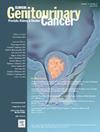Assessment of the Impact of Grade Heterogeneity on Survival in Ta and T1 Tumors: A Subgroup Analysis of NMIBC Cohort
IF 2.7
3区 医学
Q3 ONCOLOGY
引用次数: 0
Abstract
Introduction
We aimed to compare the RFS and PFS of Ta-MG, Ta-HG, T1-MG and T1-HG groups with the hypothesis that MG tumors may have a better prognosis than pure HG tumors.
Material and Methods
Patients with HG-NMIBC in the first TUR specimen between 2010 and 2020 were screened. The first TUR specimens were re-evaluated by experienced uropathologists and the percentage of LG tumor areas accompanying HG areas was determined for each case. HG tumors with accompanying LG rates ranging from 1% to 95% were evaluated as “Mixed-Grade (MG),” while tumors without any LG component (0%) were evaluated as “pure High-Grade (HG).” Survival analysis was performed using the Kaplan-Meier method. RFS and PFS were compared via the log-rank test.
Results
Of the 201 patients included in the study, 25 (12.4%) had Ta-MG, 45 (22.4%) had Ta-HG, 43 (21.4%) had T1-MG and 88 (43.8%) had T1-HG tumors. The median follow-up period of the patients was 36 months. The median number of BCG instillations received by the patients was 12 and a total of 102 patients (50.7%) received a minimum of 12 doses of BCG treatment. Recurrence was observed in 6 (24%), 11 (24.4%), 13 (30.2%) and 30 (34.1%) patients in the Ta-MG, Ta-HG, T1-MG and T1-HG groups, respectively. The 36-month RFS rates were 76% (CI: 59-93), 76% (CI: 63-88), 70% (CI: 56-84) and 66% (CI: 56-76), respectively (Log-Rank; P = .701). Progression was observed in 2 (8%), 3 (6.6%), 2 (4.6%) and 19 (21.6%) patients, respectively. The 36-month PFS rates for groups were 92% (CI: 82-100), 93% (CI: 86-100), 95% (CI: 89-100) and 78% (CI: 70-87), respectively. The T1-HG group was found to have a statistically significantly lower PFS (Log-Rank; P = .016).
Conclusion
In BCG-treated NMIBC patients, those with T1-pure-HG tumors have worse PFS compared to those with T1-MG, Ta-HG, and Ta-MG tumors. The presence of pure-HG tumors may hold prognostic importance for NMIBC patients and might be crucial for patient classification and treatment options.
分级异质性对Ta和T1肿瘤生存影响的评估:NMIBC队列的亚组分析
我们的目的是比较Ta-MG、Ta-HG、T1-MG和T1-HG组的RFS和PFS,假设MG肿瘤可能比纯HG肿瘤有更好的预后。材料与方法筛选2010 - 2020年首次TUR标本中HG-NMIBC患者。第一个TUR标本由经验丰富的泌尿病理学家重新评估,并确定每个病例LG肿瘤区域伴随HG区域的百分比。伴LG率在1%至95%之间的HG肿瘤被评估为“混合级别(MG)”,而没有任何LG成分的肿瘤(0%)被评估为“纯高级别(HG)”。采用Kaplan-Meier法进行生存分析。RFS和PFS通过log-rank检验进行比较。结果201例患者中,Ta-MG 25例(12.4%),Ta-HG 45例(22.4%),T1-MG 43例(21.4%),T1-HG 88例(43.8%)。患者的中位随访期为36个月。患者接受卡介苗注射的中位数为12次,102例患者(50.7%)接受了至少12剂卡介苗治疗。Ta-MG、Ta-HG、T1-MG和T1-HG组复发患者分别为6例(24%)、11例(24.4%)、13例(30.2%)和30例(34.1%)。36个月的RFS率分别为76% (CI: 59-93)、76% (CI: 63-88)、70% (CI: 56-84)和66% (CI: 56-76) (Log-Rank;P = .701)。分别有2例(8%)、3例(6.6%)、2例(4.6%)和19例(21.6%)患者出现进展。各组36个月PFS率分别为92% (CI: 82-100)、93% (CI: 86-100)、95% (CI: 89-100)和78% (CI: 70-87)。T1-HG组PFS显著降低(Log-Rank;P = .016)。结论在bcg治疗的NMIBC患者中,t1 -纯hg肿瘤患者的PFS较T1-MG、Ta-HG和Ta-MG肿瘤患者更差。纯hg肿瘤的存在可能对NMIBC患者的预后具有重要意义,并且可能对患者的分类和治疗选择至关重要。
本文章由计算机程序翻译,如有差异,请以英文原文为准。
求助全文
约1分钟内获得全文
求助全文
来源期刊

Clinical genitourinary cancer
医学-泌尿学与肾脏学
CiteScore
5.20
自引率
6.20%
发文量
201
审稿时长
54 days
期刊介绍:
Clinical Genitourinary Cancer is a peer-reviewed journal that publishes original articles describing various aspects of clinical and translational research in genitourinary cancers. Clinical Genitourinary Cancer is devoted to articles on detection, diagnosis, prevention, and treatment of genitourinary cancers. The main emphasis is on recent scientific developments in all areas related to genitourinary malignancies. Specific areas of interest include clinical research and mechanistic approaches; drug sensitivity and resistance; gene and antisense therapy; pathology, markers, and prognostic indicators; chemoprevention strategies; multimodality therapy; and integration of various approaches.
 求助内容:
求助内容: 应助结果提醒方式:
应助结果提醒方式:


